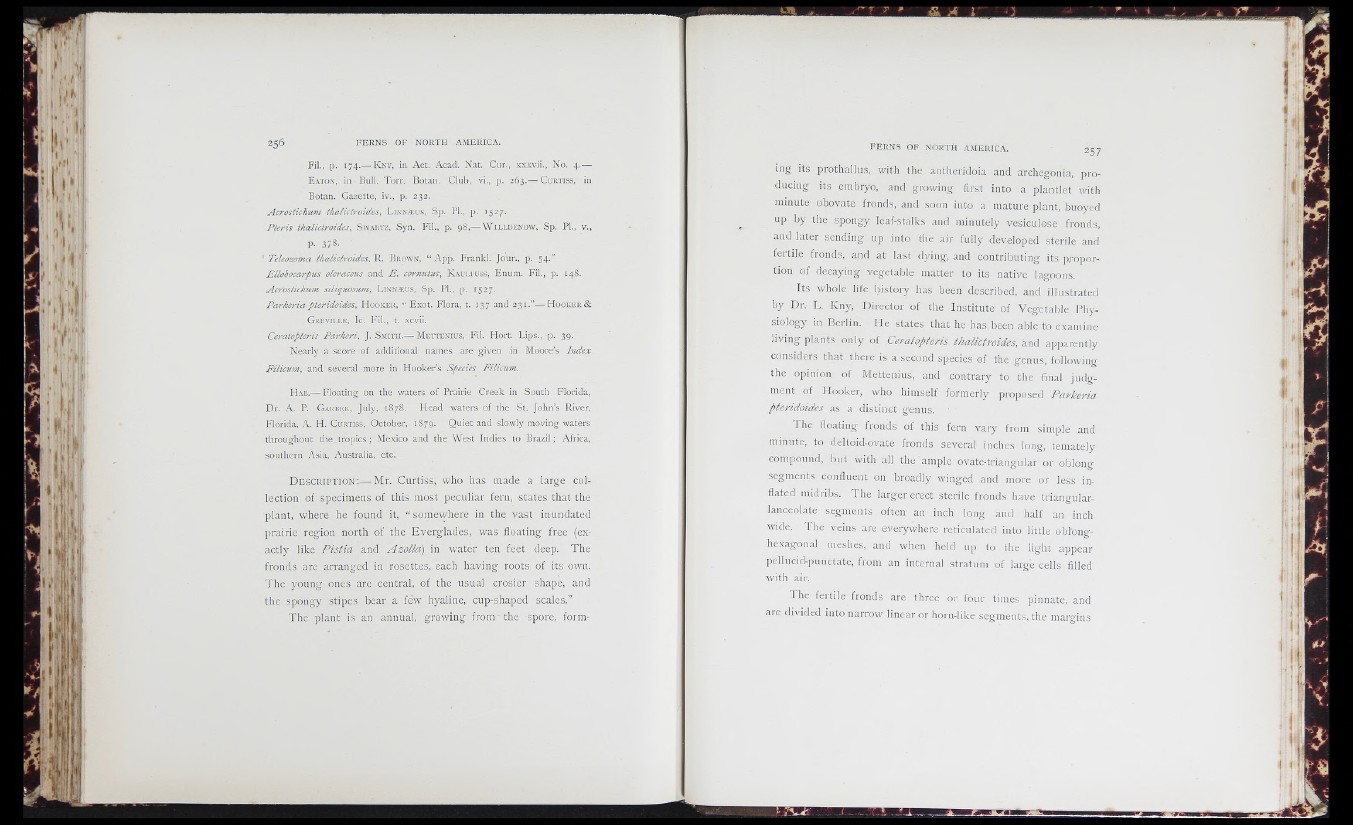
; k
■ f i .
F i l , p. 174.— K ny, in Act. Acad. Nat. Cur., x x x v i i . . No. 4.—
E a t o n , in Bull. Torr. Botan. Club, v i ., p. 2 6 3 .— Cuimss, in
Botan. Gazette, iv ., p. 2 3 2 .
Acrostichum thalictroides, L in n æ u s , Sp. P L , p. 1 5 2 7 .
Pteris thalictroides, S w a r t z , S y n . I 'i l ., p. 9 8 ,— W il l d en o w , S p . PL, v .,
P- 3 7 8 -
' Teleozoma thalictroides, R. B row n , “ App. Frankl. Jour., p. 54.”
Ellobocarpus oleraceus and E . cornutus, K a u l fu s s , Enum. Fil., p. 148.
Acrostichum siliquosicm, L in næ u s , Sp. PL, p. 1527.
Parke ria pteridoides. H o o k e r , “ Exot. Flora, t. 13 7 an d 2 3 1.”— H o o k e r &
G reville, I c. P'il., t. xcvii.
Ceratopteris Parkeri, J . S m ith .— M e t t e n iu s , P i l. H o r t . L ip s ., p . 3 9 .
Nearly a score of additional names are given in Moore’s Index
Filicicm, and several more in Hooker’s Species Filicum.
H ab.— Floating on the waters of Prairie Creek in South Florida,
Dr. A. P. G a r b e r , July, 1878. Head waters of the St. John’s River,
Florida, A. H. C u r t i s s , October, 1879. Quiet and slowly moving waters
throughout the tropics ; Mexico and the West Indies to Brazil ; Africa,
southern Asia, Australia, etc.
D e s c r i p t i o n ;— Mr. Curtiss, who has made a large collection
of specimens of this most peculiar fern, states that the
plant, where he found it, “ somewhere in the vast inundated
prairie region north of the Everglades, was floating free (exactly
like Pistia and Azolld) in water ten feet deep. The
fronds are arranged in rosettes,, each having roots of its own.
The young ones are central, of the usual crosier shape, and
the spongy stipes bear a few hyaline, cup-shaped scales.”
The plant is an annua), growing from the spore, forming
its prothallus, with the antheridoia and archegonia, pro-
ducing its embryo, and growing first into a plantlet with
minute obovate fronds, and soon into a mature plant, buoyed
up by the spongy leaf-stalks and minutely vesiculose fronds,
and later sending up into the air fully developed sterile and
fertile fronds, and at last dying, and contributing its proportion
of decaying vegetable matter to its native lagoons.
Its whole life history has been described, and illustrated
by Dr. L. Kny, Director of the Institute of Vegetable Physiology
in Berlin. He states that he has been able to examine
living plants only of Ceratopteris thatictroides, and apparently
considers that there is a second species of the genus, following
the opinion of Mettenius, and contrary to the final judgment
of Hooker, who himself formerly proposed Parkeria
pteridoides as a distinct genus.
The floating fronds of this fern vary from simple and
minute, to deltoid-ovate fronds several inches long, temately
compound, but with all the ample ovate-triangular or oblong
segments confluent on broadly winged and more or less inflated
midribs. The larger erect sterile fronds have triangular-
lanceolate segments often an inch long and half an inch
wide. The veins are everywhere reticulated into little obtong-
hexagonal meshes, and when held up to the light appear
pellucid-punctate, from an internal stratum of large cells filled
with air.
The fertile fronds are three or four times pinnate, and
are divided into narrow linear or horn-like segments, the margins
J !